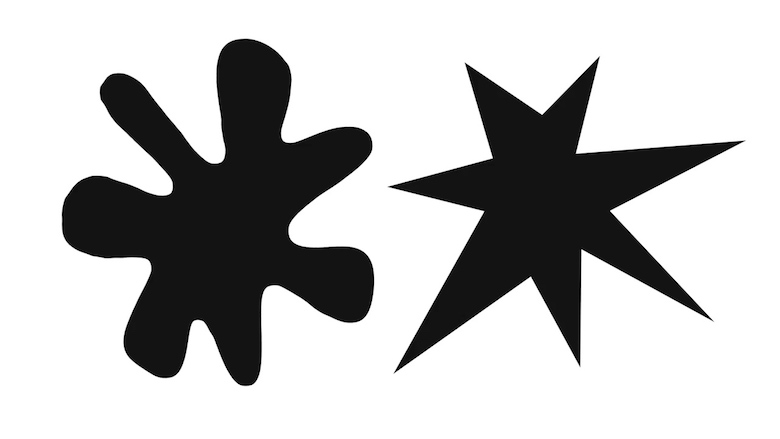In this video from Science Friday’s Macroscope series, Luke Groskin and cognitive psychologist Kelly McCormick discuss some of the theories behind the Bouba-Kiki Effect. The Bouba-Kiki Effect describes the following phenomenon: When people are presented with a pointy shape and a blob shape and given a choice between two made-up words to name each one, most associate the pointy shape with the made-up word “Kiki” and the blob shape with the made-up word “Bouba.” Originally noted by psychologist Wolfgang Kӧhler in 1929, this phenomenon has been documented around the world in a variety of cultures, regardless of language. Are people associating the sounds with particular shape characteristics like size or roundness? Let’s take a closer look at the Bouba-Kiki Effect and the three main theories proposed to explain it.
See the Educator’s Toolbox below for a student worksheet (DOC & PDF) and video transcript.
Would you prefer audio? You can listen to the radio segment Behind the Bouba-Kiki Effect (6:36). Transcript here.
In Science Friday’s video The Bouba-Kiki Effect, Kelly McCormick described three proposed explanations for the phenomenon called the Bouba-Kiki Effect. Decide which theory you think is the most likely explanation for the Bouba-Kiki Effect. Develop a paragraph that supports your claim.
Writing responses should:
— Explain one of the theories that McCormick presented.
— Provide your interpretation or example of what that theory is saying.
— Use information from the video, your group discussion, and the article to support your point.
— Address the counterclaim. Why might someone disagree with the theory you chose?
— Optional: graph the class data and compare to the data presented in the video.
See the Educator’s Toolbox below for a student worksheet (DOC & PDF).
(Printable image files: DOC & PDF)
Optional: Note information on your participants (age, gender, etc).
– Take this opportunity to sound out the words, look at their shapes, and think of the images they create in your mind.
— Theory 1- It’s Innate
— Theory 2- It’s Your Mouth
— Theory 3- It’s Learned
In Science Friday’s video The Bouba-Kiki Effect, Kelly McCormick described three proposed explanations for the phenomenon called the Bouba-Kiki Effect. You and your classmates constructed your own test to see what words (real or imagined) correlate with “pointy” and “round.” Based on the video, your group discussions, and the outcomes of your test, decide which theory you think is the most likely explanation for the Bouba-Kiki Effect. Develop a paragraph that supports your claim.
Writing responses should:
— Explain one of the theories that McCormick presented.
— Provide your interpretation or example of what that theory is saying.
— Use information from the video, your test, and your group discussion to support your point.
— Address the counterclaim. Why might someone disagree with your claim?
Rupp, Rebecca. “Kiki or Bouba: What Is the Shape of Your Taste?” The Plate. National Geographic, 26 June 2015.
CCSS.ELA-LITERACY.RI.6.7
Integrate information presented in different media or formats (e.g., visually, quantitatively) as well as in words to develop a coherent understanding of a topic or issue.
CCSS.ELA-LITERACY.RI.9-10.7
Analyze various accounts of a subject told in different mediums (e.g., a person’s life story in both print and multimedia), determining which details are emphasized in each account.
CCSS.ELA-LITERACY.W.6.1, CCSS.ELA-LITERACY.W.7.1, CCSS.ELA-LITERACY.W.8.1
Write arguments to support claims with clear reasons and relevant evidence.
CCSS.ELA-LITERACY.W.9-10.1, CCSS.ELA-LITERACY.W.11-12.1
Write arguments to support claims in an analysis of substantive topics or texts, using valid reasoning and relevant and sufficient evidence.
Xochitl Garcia is Science Friday’s K-12 education program manager. She is a former teacher who spends her time cooking, playing board games, and designing science investigations from odds and ends she’s stockpiled in the office (an in various drawers at home).
In most scientific research, upwards of 90% of people will associate a pointy polygon with “kiki” and a rounded amoeboid with “bouba.”
In study after study, 90 percent of people agree: A pointy shape is named “Kiki” and a rounded shape is “Bouba.”
Dan Pashman, host of WNYC’s The Sporkful podcast, tells us how sound can influence the taste of your food, prevent cooking mishaps, and help you to compose the…
30 Broad Street, Suite 801
New York, NY 10004
Thank you for helping us continue making science fun for everyone.
Science Friday® is produced by the Science Friday Initiative, a 501(c)(3) nonprofit organization. Created by Bluecadet